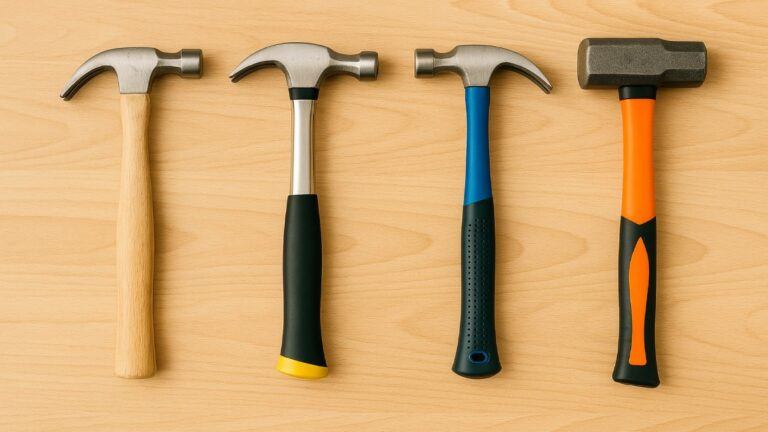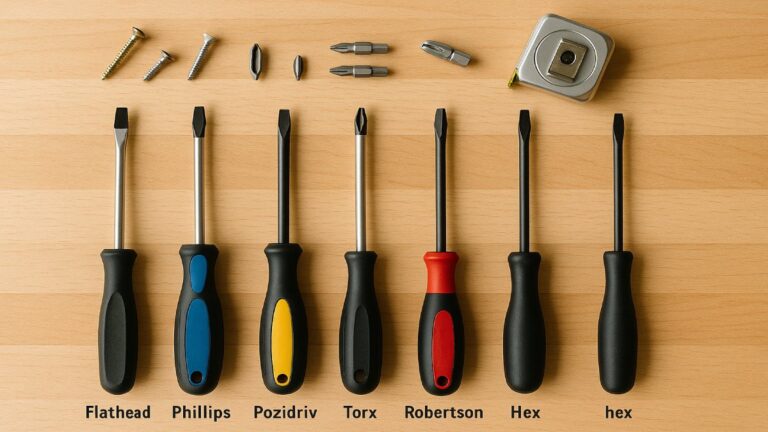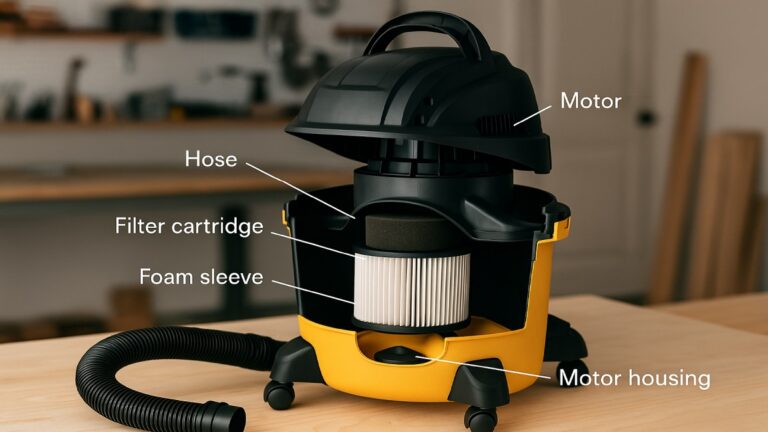Choose the Right Extension Cord for Power Tools Safely
Extension cords are essential for workshops and job sites, yet many DIYers pick them by convenience rather than safety. A poorly chosen cord can cause voltage drop, device underperformance, overheating, or even a fire. This guide explains exact steps to match cord gauge, length, and type to your tools so you get reliable power and safe operation.
Follow straightforward rules and examples to avoid common mistakes. You’ll learn how wire gauge (AWG), cord length, outdoor ratings, and grounding affect tool performance. By the end, you’ll know which cord to buy for drills, saws, compressors, and shop equipment.

Introduction — Why the Right Extension Cord Matters
Extension cords are often treated as a minor purchase, but they’re part of your electrical system when you use tools. The wrong cord reduces voltage at the tool, which lowers motor speed and increases heat. Those effects shorten tool life and raise safety risks. Proper cord selection prevents performance problems and keeps your workspace safer.
This article focuses on practical rules and real-world examples. You’ll learn to read amp ratings, select AWG sizes, and pick the right cord type for indoor and outdoor use. Use this as a checklist before you plug any high-draw tool into a cord.
Extension Cord Basics: Ratings, Jackets, and Purpose
Extension cords are rated by wire gauge, length, and jacket type. Each rating signals what the cord can safely handle. A thicker cable (lower AWG number) carries more current with less voltage drop. A heavy-duty jacket resists abrasion, UV, and moisture. Look for UL or equivalent safety marks to confirm certification.
Temporary Wiring vs Permanent Wiring
Extension cords are temporary wiring. The National Electrical Code and manufacturers recommend using them only for temporary or occasional power. If you need a permanent solution, install dedicated outlets or add circuits. Avoid the temptation to run extension cords as permanent wiring in your shop.
Indoor vs Outdoor Jackets
Outdoor-rated cords have tougher jackets designed to resist sunlight, moisture, and rough handling. They typically have designations like SJTW, SJEOW, or SOOW. For workshop and jobsite use, choose outdoor-rated cords even if you work indoors sometimes. They handle abuse better and increase lifespan.
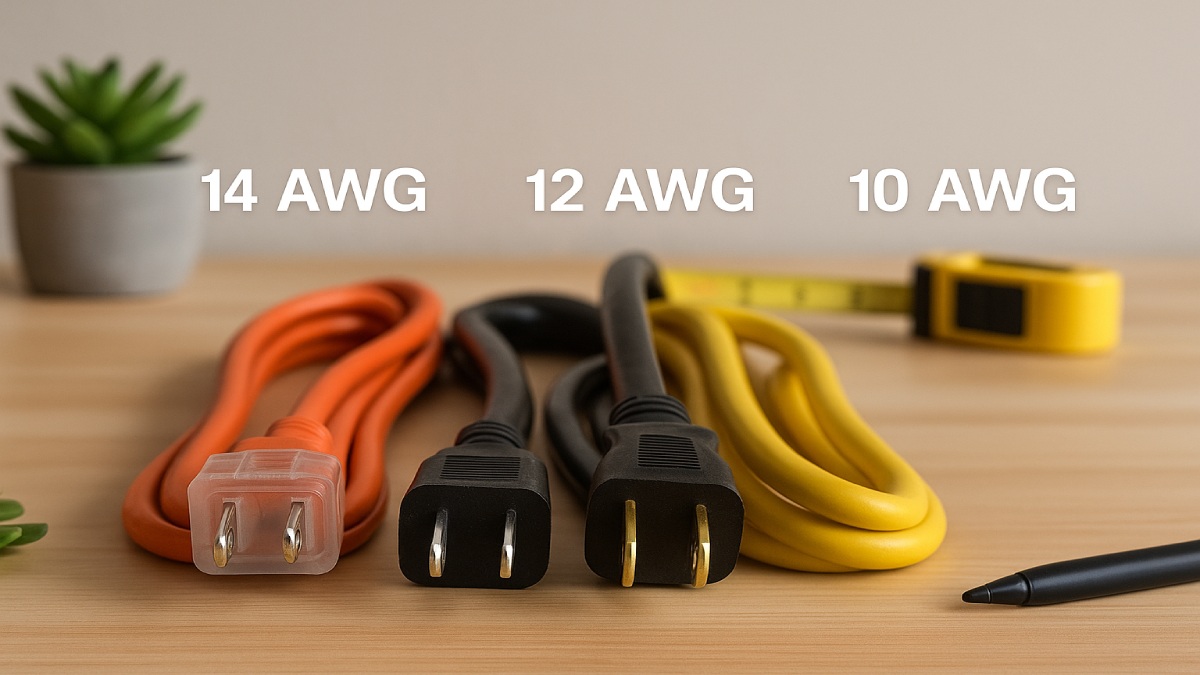
Understanding Wire Gauge (AWG)
Wire gauge—expressed as AWG—works backward: smaller numbers mean thicker conductors. A 10 AWG cord is thicker and carries more current than a 12 AWG cord. Thicker wire reduces resistance and limits voltage drop over distance. For tools that draw lots of amps, thicker wire is safer and keeps the tool performing as designed.
Common Gauge Choices and When to Use Them
- 14 AWG: Light work and short runs under 25 feet; safe for small tools like small lights or low-draw devices.
- 12 AWG: General-purpose shop use; suitable for most hand tools and circular saws on moderate runs.
- 10 AWG: Heavy-duty or long runs; ideal for compressors, table saws, and heaters across 50–100 feet.
Why Gauge Alone Isn’t Enough
Gauge is closely tied to length. A 12 AWG cord works great at 25 feet but may produce significant voltage drop at 100 feet. Always consider both gauge and length to ensure safe operation.
How Cord Length Affects Voltage Drop and Performance
Voltage drop is the loss of voltage due to resistance in the wire. The longer the cord, the greater the resistance and voltage drop. That drop reduces the power available to your tool. For motors, that means slower speed and higher current draw, which increases heating and wear.
Practical Length-to-Gauge Guidance
- Under 25 feet: 14 AWG for light tools; 12 AWG preferred for regular use.
- 25–50 feet: 12 AWG for most hand tools; 10 AWG for continuous heavy loads.
- 50–100 feet: 10 AWG for power tools and compressors; consider adding a closer outlet if possible.
Example
If your circular saw draws 12 amps and you’re using a 50-foot cord, 12 AWG might cause noticeable voltage drop. A 10 AWG cord keeps voltage higher and minimizes heating. That protects the saw motor and gives you reliable cutting speed.
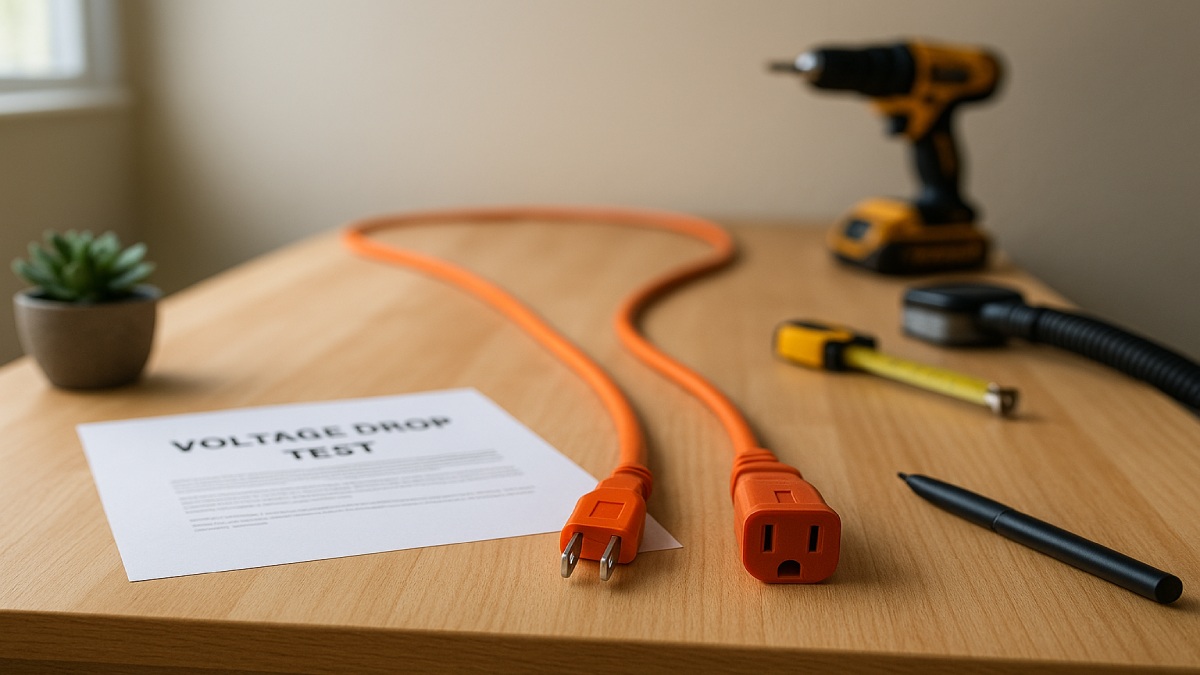
Matching Cord Gauge to Tool Amp Rating
Every power tool has a nameplate or manual listing its amp draw. That number tells you the minimum current capacity your cord should support. When in doubt, round up to the next thicker gauge. If a tool draws 15 amps, choose a cord rated for at least 15 amps and sized to limit voltage drop for your run length.
Typical Tool Amp Ranges
- Drills: 4–8 amps
- Circular saws: 9–15 amps
- Table saws and big planers: 12–20+ amps
- Air compressors (small): 10–15 amps
Quick Pairing Rules
- Hand tools under 10 amps: 12 AWG up to 50 ft is usually safe.
- Saws and high-draw tools: 12 AWG for short runs, 10 AWG for long runs.
- Compressors or continuous loads: prefer 10 AWG for both short and long runs.
Cord Types and Safety Ratings
Select cords with the right construction and safety markings. Look for UL or ETL listings and type codes that match your environment.
Common Cord Type Codes
- SJTW — General-purpose, weather-resistant, often rated for outdoor use.
- SOOW — Oil-resistant and heavy-duty; excellent for jobsite use.
- SJEOW — Extra-flexible, weather-resistant, for tools that move frequently.
Grounding and 3-Prong Use
Always use grounded (three-prong) cords with grounded tools. The third prong protects you and the tool by providing a path for fault current. Never remove a ground or use a 2-prong adapter on grounded tools.
Common Mistakes and How to Avoid Them
People often pick cords by length or color, not by amp rating or gauge. These habits lead to problems. Here are the most frequent mistakes and how to avoid them.
Mistake: Using Too-Thin Cords
Thin cords heat up and underdeliver power. If a tool slows under load or the cord or plug gets warm, stop and switch to a heavier cord.
Mistake: Daisy-Chaining Cords
Linking multiple cords together multiplies resistance, creates weak points, and increases fire risk. Use one properly sized cord or add a nearby outlet.
Mistake: Using Indoor Cords Outdoors
Indoor cords lack UV and moisture resistance. For outdoor or rough shop use, pick an outdoor-rated cord with a rugged jacket and reinforced strain relief.
Mistake: Leaving Cords in Place Permanently
Extension cords are temporary solutions. For a permanent setup, install dedicated wiring or additional outlets. Permanent cord runs are a code violation in many jurisdictions.
When to Upgrade to Heavy-Duty Extension Cords
Upgrading to heavier cords is inexpensive compared to replacing tools or repairing fire damage. Consider a heavier cord if you see any of these signs: tools lag under load, the cord or plug feels warm, circuit breakers trip, or you frequently use long runs.
Signs Your Cord Is Undersized
- Tool speed drops significantly under load.
- Cord or connector becomes hot to the touch.
- Frequent tripping of breakers when the tool runs.
Recommended Upgrades
For a busy workshop, keep a stock of 12 AWG and 10 AWG cords in common lengths (25, 50, and 100 ft). Buy outdoor-rated, heavy-duty cords for durability and safety.
Special Features Worth Paying For
Modern extension cords add convenience and safety features that are worth considering for busy shops or job sites.
LED-Indicator and Lighted Ends
Lighted plugs confirm live power and make it easier to find ends in dim spaces.
Locking Connectors
Locking ends prevent accidental unplugging from vibrating tools or moving carts.
High-Visibility Jackets
Brightly colored jackets reduce trip hazards in busy areas and help you spot cords under debris.
Built-In Surge Protection
Some cords include surge protection or resettable breakers. These help when using electronics or charging tools, but note that surge features add cost and are not a substitute for correct gauge selection.
Storage, Maintenance, and Cord Care
Proper handling greatly extends cord life. Coiling, storing, and inspecting cords prevents damage and reduces shocks and shorts.
How to Coil for Longevity
Use an over-under coil or flat wrap to avoid internal twisting. Twisted internal wires can break insulation and create hot spots.
Proper Storage
Store cords off the floor, away from heat, oil, and sharp edges. Hang them on hooks or store in bins where moisture won’t collect.
Inspection Routine
Inspect cords before each use. Look for cuts, crushed sections, exposed copper, or damaged prongs. Replace any cord with visible damage. Don’t tape over frayed insulation; replace it.
Buying Guide — Best Extension Cords by Scenario
Use this quick guide to pick cords for common situations.
For Garage Workshops
12 AWG, 25–50 ft, outdoor-rated, with grounded 3-prong ends. Good for most saws and drills at short to medium distances.
For Outdoor Job Sites
10 AWG, contractor-grade (SOOW or SJEOW), 50–100 ft. Choose heavy-jacket, oil-resistant cords with locking ends for secure connections.
For Light DIY Around the House
14 AWG, under 25 ft, indoor-rated is acceptable for lights and low-draw tools. For occasional power to larger tools, prefer 12 AWG.
For Compressors and High-Draw Tools
10 AWG minimum if the run exceeds 25–50 ft. Short runs can sometimes use 12 AWG, but 10 AWG gives extra margin and reduces heat buildup.
FAQs — Quick Answers
Can I use a 16-gauge cord for power tools?
Not for most power tools. 16-gauge is light-duty and suited to lamps or small electronics. Avoid 16-gauge for saws, compressors, or tools above a few amps.
What length is safe for a circular saw?
Prefer under 50 feet. If you must run longer, move to 10 AWG to reduce voltage drop. Shorter is always better.
Are retractable reels safe for power tools?
Retractable reels often have thin internal cords and heat when fully extended. Use reels rated for the tool’s amp draw and fully extend the cord when running high-draw tools to improve cooling.
Why does my tool slow when using a long cord?
Slowing indicates voltage drop. The cord is adding resistance so less voltage reaches the motor. Use a thicker cord or shorter run to restore performance.
Should I buy one heavy-duty cord or multiple sizes?
Both approaches work. A single heavy-duty cord covers most needs but is bulky. A set of 25 ft and 50 ft cords in 12 and 10 AWG gives flexibility and makes handling easier.
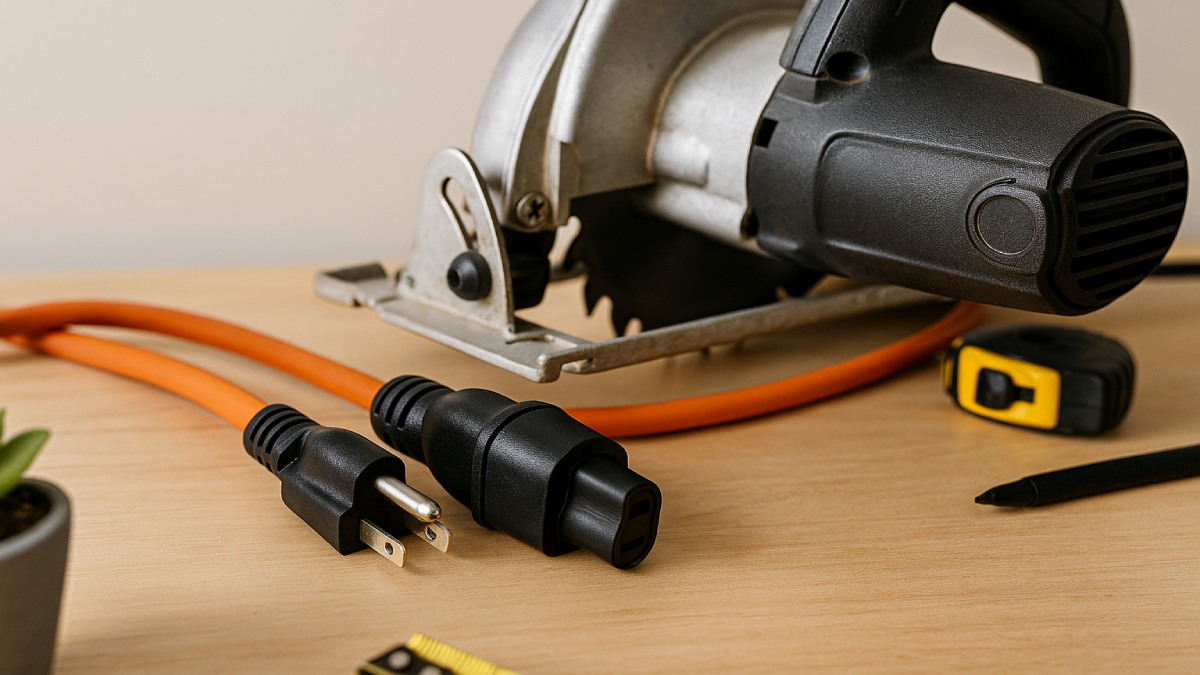
Conclusion — Simple Rules for Safe, Reliable Tool Power
Match wire gauge to your tool’s amp draw and the length of run. Prefer outdoor-rated, grounded cords for workshop and jobsite use. Replace damaged cords immediately, avoid daisy-chaining, and use locking or high-visibility features when needed. These basic practices protect your tools, improve performance, and keep your workspace safer.
When in doubt, pick the thicker cord. The small extra cost yields longer tool life, more consistent power, and much greater safety. Keep a handful of properly sized cords on hand and make cord selection a routine part of your project prep.




